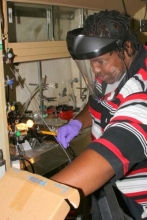
University:
Jackson State University
Major:
Chemical Engineering
Mentor(s):
Isaac Riisness
Faculty Sponsor(s):
Michael J. Gordon
Faculty Sponsor's Department(s):
Chemical Engineering
Project Title:
LIGHTS, CAMERA, ACTION! MOLECULAR SURFACE IMAGING VIA ENHANCED LIGHT-MATTER INTERACTIONS
Project Description:
Scanning probe microscopy (SPM) is an efficient technique for surface characterization on the
nanoscale. By using one form of STM, scanning tunneling microscopy (STM), one is able to
surpass the wavelength diffraction limit and clearly image surfaces on the atomic level. Raman
spectroscopy is a technique used for the unique detection for molecules’ rotational, vibrational,
and other low frequency modes via light scattering. The ultimate goal of this project is to
develop a hybrid SPM system that can topographically and chemically image surfaces with
nanoscale spatial resolution. The instrument simultaneously applies atomic force microscopy
(AFM) and STM with near field optical examination, using electrochemically etched tips to
amplify the Raman signal from the surface for SPM. The tips are probed across the fabricated
surface, where powerful electromagnetic fields are created, ultimately allocating surface
chemical imaging through near-field vibrational [Raman] spectroscopy. For the STM-Raman
conjunction, glass slides are coated with gold and have thiol-linkers attached, where STM
imaging using Au, W, and Ag tips allow for the surface imaging. The slides are then struck by
laser light for molecular excitation, thus allowing detection of the linkers groups, allowing
nanoscale detection and imaging via unique chemical signaling. In this work, techniques are
currently being developed for higher image resolution and STM tip fabrication processes.
